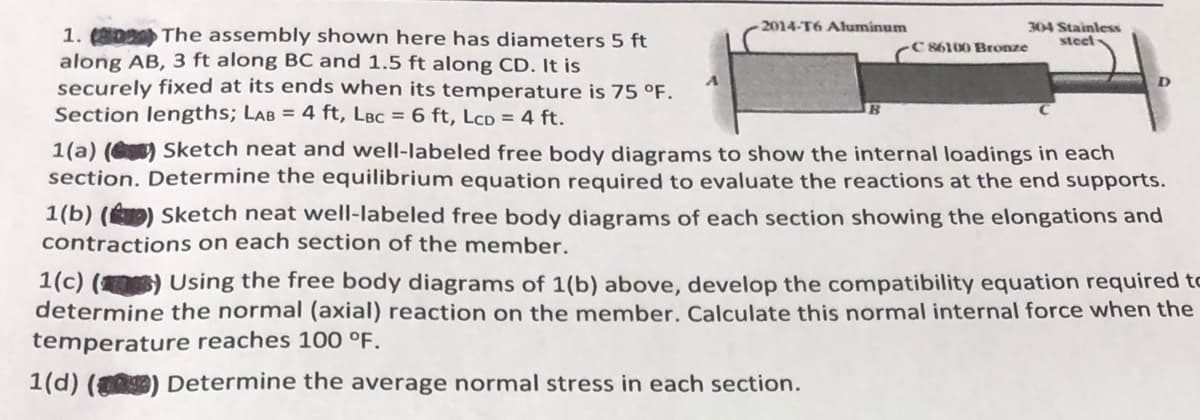1. The assembly shown here has diameters 5 ft along AB, 3 ft along BC and 1.5 ft along CD. It is securely fixed at its ends when its temperature is 75 °F. Section lengths; LAB = 4 ft, LBC = 6 ft, LcD = 4 ft. 2014-T6 Aluminum 304 Stainless steel C 86100 Bronze D 1(a) () Sketch neat and well-labeled free body diagrams to show the internal loadings in each section. Determine the equilibrium equation required to evaluate the reactions at the end supports. 1(b) () Sketch neat well-labeled free body diagrams of each section showing the elongations and contractions on each section of the member. 1(c) () Using the free body diagrams of 1(b) above, develop the compatibility equation required to determine the normal (axial) reaction on the member. Calculate this normal internal force when the temperature reaches 100 °F. 1(d) (0) Determine the average normal stress in each section.
1. The assembly shown here has diameters 5 ft along AB, 3 ft along BC and 1.5 ft along CD. It is securely fixed at its ends when its temperature is 75 °F. Section lengths; LAB = 4 ft, LBC = 6 ft, LcD = 4 ft. 2014-T6 Aluminum 304 Stainless steel C 86100 Bronze D 1(a) () Sketch neat and well-labeled free body diagrams to show the internal loadings in each section. Determine the equilibrium equation required to evaluate the reactions at the end supports. 1(b) () Sketch neat well-labeled free body diagrams of each section showing the elongations and contractions on each section of the member. 1(c) () Using the free body diagrams of 1(b) above, develop the compatibility equation required to determine the normal (axial) reaction on the member. Calculate this normal internal force when the temperature reaches 100 °F. 1(d) (0) Determine the average normal stress in each section.
Steel Design (Activate Learning with these NEW titles from Engineering!)
6th Edition
ISBN:9781337094740
Author:Segui, William T.
Publisher:Segui, William T.
Chapter5: Beams
Section: Chapter Questions
Problem 5.8.3P
Related questions
Question
1 Please help ASAP.
Help with parts A-B
Provide Free Body Diagram, labeled with appropriate quantities to better understand. Also solve. Thank you.

Transcribed Image Text:2014-T6 Aluminum
304 Stainless
steel-
1.
The assembly shown here has diameters 5 ft
along AB, 3 ft along BC and 1.5 ft along CD. It is
securely fixed at its ends when its temperature is 75 °F.
Section lengths; LAB = 4 ft, LBC = 6 ft, LCD = 4 ft.
1(a) () Sketch neat and well-labeled free body diagrams to show the internal loadings in each
section. Determine the equilibrium equation required to evaluate the reactions at the end supports.
1(b)
Sketch neat well-labeled free body diagrams of each section showing the elongations and
contractions on each section of the member.
C 86100 Bronze
D
1(c) () Using the free body diagrams of 1(b) above, develop the compatibility equation required to
determine the normal (axial) reaction on the member. Calculate this normal internal force when the
temperature reaches 100 °F.
1(d) (0) Determine the average normal stress in each section.
Expert Solution
This question has been solved!
Explore an expertly crafted, step-by-step solution for a thorough understanding of key concepts.
This is a popular solution!
Trending now
This is a popular solution!
Step by step
Solved in 6 steps with 13 images

Knowledge Booster
Learn more about
Need a deep-dive on the concept behind this application? Look no further. Learn more about this topic, civil-engineering and related others by exploring similar questions and additional content below.Recommended textbooks for you

Steel Design (Activate Learning with these NEW ti…
Civil Engineering
ISBN:
9781337094740
Author:
Segui, William T.
Publisher:
Cengage Learning

Solid Waste Engineering
Civil Engineering
ISBN:
9781305635203
Author:
Worrell, William A.
Publisher:
Cengage Learning,

Steel Design (Activate Learning with these NEW ti…
Civil Engineering
ISBN:
9781337094740
Author:
Segui, William T.
Publisher:
Cengage Learning

Solid Waste Engineering
Civil Engineering
ISBN:
9781305635203
Author:
Worrell, William A.
Publisher:
Cengage Learning,